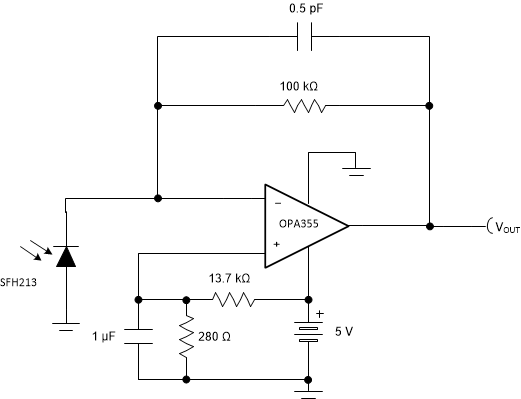SBOS195E March 2001 – April 2018 OPA2355 , OPA3355 , OPA355
PRODUCTION DATA.
- 1 Features
- 2 Applications
- 3 Description
- 4 Revision History
- 5 Device Comparison Table
- 6 Pin Configuration and Functions
- 7 Specifications
- 8 Detailed Description
- 9 Application and Implementation
- 10Power Supply Recommendations
- 11Layout
- 12Device and Documentation Support
- 13Mechanical, Packaging, and Orderable Information
Package Options
Mechanical Data (Package|Pins)
Thermal pad, mechanical data (Package|Pins)
Orderable Information
9.2.1.2 Detailed Design Procedure
To achieve a maximally-flat, second-order Butterworth frequency response, set the feedback pole to:

Use Equation 2 to calculate the bandwidth.

For other transimpedance bandwidths, consider the high-speed CMOS OPA380 (90-MHz GBW), OPA354 (100-MHz GBW), OPA300 (180-MHz GBW), OPA355 (200-MHz GBW), or OPA656 and OPA657 (400-MHz GBW).
For single-supply applications, the +INx input is biased with a positive DC voltage to allow the output to reach true zero when the photodiode is not exposed to any light, and respond without the added delay that results from coming out of the negative rail. Figure 32 shows this configuration. This bias voltage appears across the photodiode, providing a reverse bias for faster operation.
 Figure 32. Single-Supply Transimpedance Amplifier
Figure 32. Single-Supply Transimpedance Amplifier For additional information, see Compensate Transimpedance Amplifiers Intuitively.